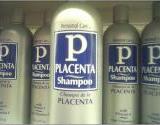Main Menu
Placenta Shampoo
Placenta in your shampoo? You read that right – there are hair-washing products on the market that contain placenta. The protein in the placenta is supposed to add shine to hair. But does it really work - and whose placenta is it, anyway?
Placenta shampoo gained popularity in the 1980s, and is still somewhat popular today. There are several brands of it on the market: La Bella, Hask Placenta, Queen Helene, Eko and Thermo Group, and Bellekiss, to name just a few. So how much placenta is in this shampoo – and where does it come from?
PETA reports that bovine placenta – which, if the name didn’t clue you in, comes from cows - is found not only in shampoos, but also in skin products like creams and masks. Other shampoos contain sheep placenta. It’s rigorously sterilized before it’s added to shampoo, so although it sounds gross, it’s actually not dirty. The amount of placenta in shampoo is usually extremely low. It’s intended to condition and strengthen the hair. Cosmetic chemists say, however, that placenta has little effect on hair – it’s the other conditioning ingredients in shampoo that usually give hair its softness and shine.
But there’s another variety of placenta that shows up in shampoo – plant placenta. Yes, a plant has a placenta. The pistil of a flowering plant is composed on the stigma, style, and ovary. The placenta is the inner wall of the ovary where the plant’s ovules are attached. Some shampoos, like Bellekiss, claim that plant placenta stimulates hair growth, but there’s no scientific evidence to back up this claim. Sometimes it’s not clear whether the placenta listed in shampoo is of the animal or plant variety, which can confuse consumers, and rightly so.
Since a woman’s hair often becomes thicker and shinier when she is pregnant, placenta can be an alluring ingredient in a shampoo, because it’s linked to the improved hair quality of pregnancy. There’s really no evidence, however, that placenta shampoo does anything special for hair.
Related Articles
This information is solely for informational and educational purposes only. The publication of this information does not constitute the practice of medicine, family planning, child psychology, marriage counseling and this information does not replace the advice of your physician or other health care or mental health care provider. Neither the owners or employees of NaturalFamilyOnline.com or the author(s) of site content take responsibility for any possible consequences from any treatment, procedure, exercise, dietary modification, application of medication or any other action involving the care of yourself or any family members which results from reading this site. It is always best to speak with your primary health care provider before engaging in any form of self treatment. Additional information contained in our Legal Statement


